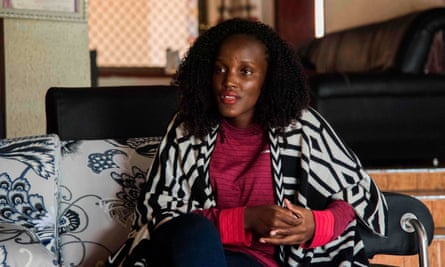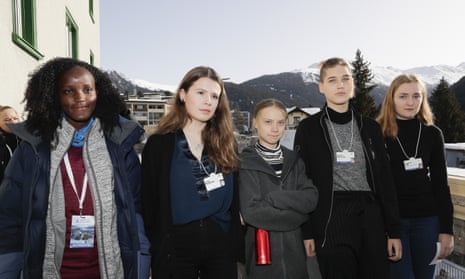When Vanessa Nakate addressed a tweet to the Associated Press asking why she had been cropped out of a photo, it was out of curiosity. She didn’t think her question would ignite a firestorm of criticism and spark an international conversation on erasure and diversity within the environmental movement.
“When I saw the photo, I only saw part of my jacket. I was not on the list of participants. None of my comments from the press conference were included,” she said. “It was like I wasn’t even there.”
The 23-year-old Ugandan activist had appeared at a joint press conference in Davos with other prominent climate activists, including Greta Thunberg, Loukina Tille, Luisa Neubauer and Isabelle Axelsson.
But when the news agency published a picture of the event, Nakate had been cut from the image – which showed only the four white activists.
Speaking up catapulted Nakate into an unfamiliar territory of social activism: calling out anti-black discrimination and racism. After experiencing “the definition of the word” for the first time in her life, she received messages of support. She said she now felt a greater responsibility to “amplify their voices”.
“Climate activists of color are erased,” she said. “I [had] activists who messaged me to tell me that the same thing happened to them before but they didn’t have the courage to say anything.”
After a wave of outcry, the cropped photo was replaced on the AP wire, and the agency apologized to Nakate, both publicly and in person. “We train our journalists to be sensitive to issues of inclusion and omission. We have spoken internally with our journalists and we will learn from this error in judgment,” said Sally Buzbee, the AP’s executive editor, in a statement.
The agency said that the crop was an honest mistake with no ill intent, but Nakate was skeptical.

“They changed the photo to where I was in the middle. That means they had other photos and chose to use that one,” she said. “So no, I don’t believe their statement or their apology.”
And what some dismiss as an error, she said, reflects the constant silencing of diverse voices in climate action groups.
Nakate was among dozens of youth activists globally who convened for a weekend of workshops and panels. But media coverage of the event didn’t show the diversity of those who attended. Nakate only learned of the crop after struggling to find images that included her.
Jamie Margolin, founder of the climate action group Zero Hero, said this exclusion of activists of color was part of a culture of silencing marginalized communities disproportionately affected by the climate crisis.
“Racism, classism and the erasure of marginalized voices isn’t new,” she said. “A photo crop-out is an easy way to describe it but it’s really a metaphorical crop-out from the narrative of climate science in general.”
Margolin recalled instances when activists were left out of clips, transcripts and other coverage of events – even those they had organized.
While Margolin was initially surprised to hear it was Nakate’s first experience with racism, she said growing up in Uganda may have shielded her from the discrimination minority activists often face elsewhere.
“Many of us haven’t spoken out because it isn’t unusual to us,” she said. “Environmental activism has been framed as Europe influencing the world – not the other way around. We’ve become used to our perspectives being excluded.”
Climate researchers say that poor, mostly minority communities will face the brunt of the climate crisis, making their presence and power within activist circles vital.
“It’s disgraceful that not only is Africa ignored, it’s also deliberately removed from the picture,” said Theo Cullen-Mouze, a 17-year-old Irish climate activist. “Africa has contributed the least [carbon emissions] but will suffer the most from climate breakdown.”
Dr Robert Bullard is widely considered the “father of environmental justice”, introducing the discipline in the early 1980s to “dispel the myth or misconception that African Americans and other people of color” don’t care about climate science. He said the cropping incident was “a symptom of a larger pathology” that isn’t “unique to climate or environmental fields”.
“Climate activism among youth is perceived by the larger society as a ‘white thing’. The un-cropped photo didn’t fit the model,” he said. “Racism has the intended purpose of making people of color invisible.”
A Kampala native, Nakate is the founder of the climate action groups Youth for Future Africa and the Rise Up Movement. She drew inspiration from Thunberg in leading a strike outside the Ugandan parliament to protest against climate inaction and rising temperatures. Nakate has also campaigned for climate initiatives across the continent, including protecting rainforests in Congo.
Her Twitter question prompted responses from other black, Latinx and indigenous activists, all expressing their own frustrations at being erased in favor of white counterparts.
“As much as this incident has hurt me personally, I’m glad because it has brought more attention to activists in Africa,” she said. “Maybe media will start paying attention to us not just when we’re the victims of climate tragedies.”
As a white Latina, Margolin said she understood she had often toed a line between inclusion and exclusion. She recalled instances when she was both “the white girl left in” a photo or “the Latina left out”.
“[Nakate’s] experience made me reflect on the conferences where the picture didn’t include the dark-skinned activists next to me – and I realize now I should have spoken up,” she said.
